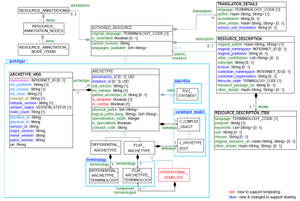This page is for discussing just the descriptive meta-data of archetypes, templates and other knowledge artefacts.
Current Model
Status
The current AOM 1.5 draft model of meta-data is shown at the right. In the this model, the blue attributes are to do with identification and are discussed in the Knowledge Artefact Identification proposal. The attributes in green are the ones that concern us here. The model currently is not much changed from the ADL 1.4 meta-data model, which is more or less the same as the model in ISO 13606-2.
Design Approach
...
Design Approach
The meta-data model only includes meta-data items that are definitional, not ones that are classificatory or otherwise arbitrary. The latter would be stored in a registry. The definitional items are separated into three groups.
- Things that don't make sense to translate, e.g. original_language (coded), original_author (a person's name) and so on. Non-translatable things are in the
descriptionproperty. - Items that should be translated (things like keywords, use, misuse, etc), in the
description.detailsproperty. - The meta-data of translations (i.e. who did it etc) are in the
translationsproperty.
...
Proposed Model
In the
...
AOM 2 model of meta-data below:
- copyright has been moved to the non-translated top-level description
- licence has been added to the description
- custodian_namespace has been added to the description
- custodian_organisation has been added to the description
- original_namespace has been added to the description
- original_publisher has been added to the description
Moving Forward
Below are two tables, the first containing the definitional properties, and the second an initial set of registry properties. Although registry properties are open-ended, it seems useful to list some key ones and name them, primarily to allow us to a) know we don't want them in the definitional property list and b) standardise them (at least somewhat) for tools. It is clear that various improvements can be made, so the tables provide a way to crystallise a new proposal.
...
| Property id | Formal def | Meaning | Correspondences | Translatable | Review comments |
|---|---|---|---|---|---|
| original_language | TERMINOLOGY_CODE [1] | ISO 639 code for the language in which the archetype was originally authored. | - | ||
| is_controlled | Boolean | - | |||
| provenance_id | UID | Id set at creation and thereafter never modified; serves as a handle on the artefact, no matter how it is changed over its lifetime | - | ||
| instance_id | UID | Id set and changed every single time the artefact is changed at the character level. | - | ||
| description.copyright | String | Copyright string | N | Move from translatable to non-translatable resource | |
| description.license | String | License text or license reference URL | N | Not only the copyright is important, but also the applicable license to the archetype. | |
| description.custodian_namespace | INTERNET_ID | Reverse internet domain of current custodian organisation | N | ||
| description.custodian_organisation | String | Human readable name of current custodian organisation | N | ||
| description.original_namespace | INTERNET_ID | Reverse internet domain of original publishing organisation | N | ||
| description.original_publisher | String | Human readable name of original publishing organisation | N | ||
| translations.language | TERMINOLOGY_CODE [1] | N | |||
| translations.author | Hash <String, String> | N | |||
| translations.accreditation | String | N | |||
| translations.other_details | N | ||||
| translations.version_last_translated | String | N | |||
| description.original_author | N | ||||
| description.other_contributors | N | ||||
| description.details.language | Main detailed description of archetype contents | Y | |||
| description.details.purpose | Y | ||||
| description.details.use | Y | ||||
| description.details.misuse | Y | ||||
| description.details.keywords | Y | ||||
| description.validation_date | String | Date of validation (not present if not validated) | N | TB: should be a registry item | |
| description.valid_until | String | Date when this archetype needs to be revised | N | TB: should be a registry item | |
| description.validator | String | Entity, Organization, or person who is responsible of the validity of the archetype | N | Maybe a better world for this field would be 'expeditor' TB: should be a registry item | |
Registry Properties
The following are properties that can't realistically be a) stable or b) maintained as meta-data within an archetype, but can or do make sense in a registry of a particular publisher / governance organisation.
| Property id | Formal Definition | Meaning | Use |
|---|---|---|---|
| valid_rms | List<String> | List of Reference model releases for which this artefact is valid | |
| version | String | Version of the archetype | |
